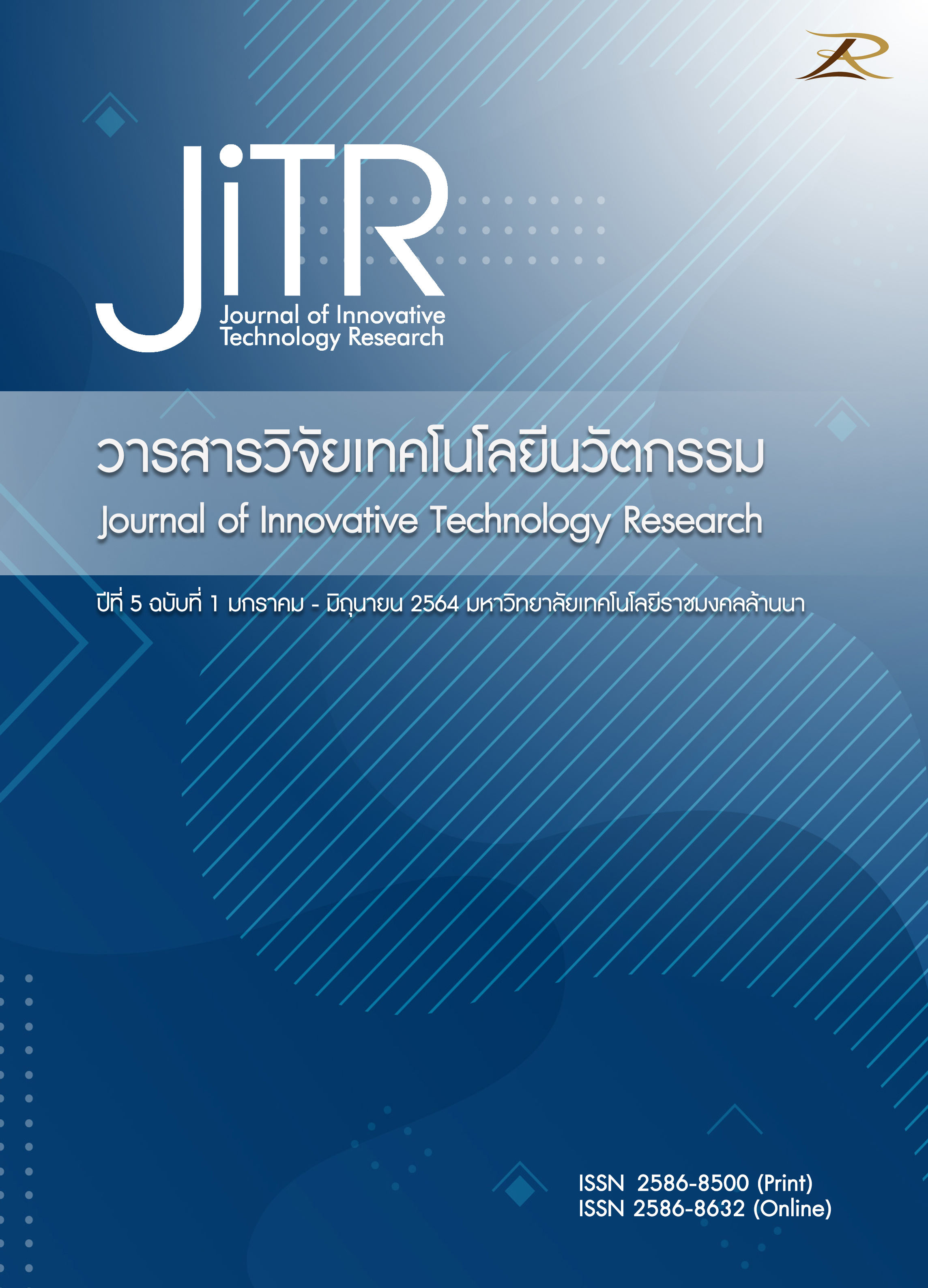การเปรียบเทียบคุณลักษณะการหมักถั่วเหลืองด้วย Aspergillus oryzae และ Bacillus subtilis
คำสำคัญ:
ถั่วเหลืองหมักบทคัดย่อ
การศึกษานี้มีวัตถุประสงค์เพื่อ เปรียบเทียบการใช้ Aspergillus oryzae และ Bacillus subtilis ในการหมักถั่วเหลือง 3 รูปแบบ ได้แก่ ถั่วเหลืองบดหมักจากกล้าเชื้อ A. oryzae (SA) ถั่วเหลืองบดหมักจากกล้าเชื้อ B. subtilis (SB) และถั่วเหลืองบดหมักจากกล้าเชื้อ A. oryzae ผสมกับถั่วเหลืองบดหมักจากกล้าเชื้อ B. subtilis (SAB) ผลการศึกษาพบว่า ถั่วเหลืองบดหมักทั้ง 3 สิ่งทดลอง มีปริมาณไนโตรเจนของกรดแอมิโนอิสระเพิ่มขึ้นตามระยะเวลาการหมักที่เพิ่มขึ้น ส่วนโปรตีนที่ละลายได้ทั้งหมดมีการเปลี่ยนแปลงในลักษณะที่แปรผกผันกับปริมาณไนโตรเจนของกรดแอมิโนอิสระ โดยถั่วเหลืองบดหมักจากกล้าเชื้อ A. oryzae (SA) นาน 90 วัน ให้ปริมาณไนโตรเจนของกรดแอมิโนอิสระสูงสุดเท่ากับ 8909±249 มิลลิกรัมต่อกิโลกรัม (p<0.05) และได้รับการประเมินคุณภาพทางประสาทสัมผัสด้านคะแนนความชอบโดยรวมเฉลี่ยในระดับชอบปานกลางถึงชอบมาก
เอกสารอ้างอิง
[1] พัทธินันท์ วาริชนันท์. (2555). ถั่วเน่า ถั่วเหลืองหมัก โภชนาการสูงภูมิปัญญาชาวบ้านทางภาคเหนือของไทย. วารสารอาหาร. 42 (4): 281-286.
[2] นิอร โฉมศรี. 2555. จุลชีววิทยาอาหาร. สำนักพิมพ์ บริษัท เชียงใหม่ปรินท์ติ้ง, เชียงใหม่, 170 น.
[3] นิอร โฉมศรี และอัมฤทธิ์ สีกล่อม. 2562. การใช้งาม้อนเป็นซับสเตรตร่วมกับถั่วเหลืองและแป้งสาลีเพื่อการหมักซีอิ๊ว. รายงานสืบเนื่องจากการประชุมทางวิชาการระดับชาติ (Proceedings) ราชภัฏเลยวิชาการ ครั้งที่ 5 ประจำปี 2562 “วิจัยและนวัตกรรมเพื่อการพัฒนาท้องถิ่นอย่างยั่งยืน” 22 มีนาคม 2562. มหาวิทยาลัยราชภัฏเลย จังหวัดเลย. น. 765-771.
[4] วราวุฒิ ครูส่ง และรุ่งนภา พงศ์สวัสดิ์มานิต. 2532. เทคโนโลยีการหมักในอุตสาหกรรม. โอเดียนสโตร์. กรุงเทพฯ. 209 น.
[5] วิเชียร ลีลาวัชรมาศ. 2534. ซีอิ๊ว. สำนักพิมพ์โอเดียนสโตร์. กรุงเทพมหานคร. 189 น.
[6] วิกิพีเดีย สารานุกรมเสรี. 2563. การหมักดอง. แหล่งที่มา: https://th.wikipedia.org/wiki/การ- หมักดอง, 27 กุมภาพันธ์ 2563.
[7] สุมณฑา วัฒนสินธุ์. 2549. จุลชีววิทยาทางอาหาร. จามจุรีโปรดักส์, กรุงเทพฯ. 436 น.
[8] สุพรรณี เทพอรุณรัตน์. 2550. อาหารหมัก. วารสารกรมวิทยาศาสตร์บริการ. 55 (175).
[9] นิรนาม. 2563. เครื่องปรุงรสไทยดาวเด่นยุคโควิด ดันส่งออก 2 เดือน 135 ล้านเหรียญสหรัฐ. ประชาชาติธุรกิจออนไลน์. แหล่งข้อมูล: https://www.prachachat.net/economy/news-450231. ค้นเมื่อวันที่ 27 พฤษภาคม 2563.
[10] Abiose, S.H., M.C. Allan and B.J. B. Wood, 1982. Microbiology and biochemistry of miso (soy paste) fermentation. Advances in Applied Microbiology, 28: 239–265.
[11] An, F. Li, M. Zhao, Y. Zhang, Y., Mu, D. Xinyu Hu, X., You, S., Wu, J. and Wu, R. 2020. Metatranscriptome-based investigation of flavor-producing core microbiota in different fermentation stages of dajiang, a traditional fermented soybean paste of Northeast China. Food Chemistry : 1-9 p.
[12] Aviles-Gaxiola, S., Chuck-Hernandez, C., Rocha-Pizana, M. R., Garcia-Lara, S., Lopez-Castillo, L. M. and Serna-Saldivar, S. O. 2018. Effect of thermal processing and reducing agents on trypsin inhibitor activity and functional properties of soybean and chickpea protein concentrates. LWT - Food Science and Technology 98: 629–634.
[13] Bradford, M.M. 1976. A rapid and sensitive method for quantitation of microgram quantities of protein utilizing the principle of protein-dye-binding. Analytical Biochemistry 72: 248-254.
[14] Chomsri, N. Intaramoree, S. and Sunantha, W. 2013. Miso Fermentation by Mixed Cultures. RMUTP Research Journal, Special Issue (The 4th Rajamangala University of Technology International Conference), 249-257.
[15] Chomsri, N., Intaramoree, S. and Wongputtisin, P. 2015. Miso production using Thai rice as co-substrate. Proceedings of CRCI. 2015. The 2nd Conference on Research and Creative Innovations 2105. 14-15 September 2015. Chiang Mai, Thailand. pp. 187-192.
[16] Cui, J., Xia, P. Zhang, L., Hu, Y. Xie, Q. and Xiang, H. 2020. A novel fermented soybean, inoculated with selected Bacillus, Lactobacillus and Hansenula strains, showed strong antioxidant and anti-fatigue potential activity. Food Chemistry 333 (127527): 1-10 p.
[17] Intaramoree, S. and Chomsri, N. 2014. Miso produced from different Thai rice cultivars: physicochemical and sensory characteristics. Proceeding: The Technology and Innovation toward ASEAN, The 5th Rajamangala University of Technology International Conference. Rajamangala University of Technology Suvarnabhumi, Phranakhon Si Ayutthaya, Thailand, 23-25 July 2014. pp. 487-495 pp.
[18] Jamaluddin, A., Rashid, N. Y. A., Razak, D. L. A., Sharifudin, S. A. and Long, K. 2014. Effect of fungal fermentation on tyrosinase and elastase inhibition activity in rice bran. Agriculture and Agricultural Science Procedia 2: 252-256.
[19] Kaewkrod, A., Niamsiri, N., Likitwattanasade, T. and Lertsiri, S. 2018. Activities of macerating enzymes are useful for selection of soy sauce koji. LWT - Food Science and Technology 89: 735–739.
[20] Kim, S. S. Kwak, H. S. and Kim, M. J. 2020. The effect of various salinity levels on metabolomic profiles, antioxidant capacities and sensory attributes of doenjang, a fermented soybean paste. Food Chemistry 328 (127176): 1-10 p.
[20] Kirk, R. and R. Sawyer. 1991. Pearson’s composition and analysis of foods. Longman Scientific & Technical. London. 708 p.
[21] Li, W. and Wang, T. 2021. Effect of solid-state fermentation with Bacillus subtilis lwo on the proteolysis and the antioxidative properties of chickpeas. International Journal of Food Microbiology 338 (108988): 1-8 p.
[22] Nguyen, T. and Nguyen, C. H. 2019. Determination of factors affecting the protease content generated in fermented soybean by Bacillus subtilis 1423. Energy Reports 6: 831–836.
[23] Nielsen, S. S. 2017. Food Analysis Laboratory Manual. Springer. Lafayette, Indiana. 249 p.
[24] Rai, A. K., Sanjukta, S., Chourasia, R., IBhat, I., Bhardwaj, P. K. and Sahoo, D. 2017. Production of bioactive hydrolysate using protease, b-glucosidase and a-amylase of Bacillus spp. isolated from kinema. Bioresource Technology. 235: 358–365.
[25] Park, M. K. and Kim, Y. S. 2020. Comparative metabolic expressions of fermented soybeans according to different microbial starters. Food Chemistry 305 (125461): 1-10 p.
[26] Teng, D., Gao, M., Yang, Y., Liu, B., Tian, Z. and Wang, J. 2012. Bio-modification of soybean meal with Bacillus subtilis or Aspergillus oryzae Biocatalysis and Agricultural Biotechnology 1: 32–38.
[27] Vagadia, B. H., Vanga, S. K. and Raghavan, V. 2017. Inactivation methods of soybean trypsin inhibitor A review. Trends in Food Science & Technology 64: 115-125.
[28] Wang, L., Luo, Y., Wu, Y. and Zhenqiang Wu, Z. 2018. Impact of fermentation degree on phenolic compositions and bioactivities during the fermentation of guava leaves with Monascus anka and Bacillus sp. Journal of Functional Foods 41: 183–190.
[29] Wei, Q., Wolf-Hall, C. and CHANG, K. C. 2001. Natto characteristics as affected by steaming time, Bacillus strain, and fermentation time. Journal of food science 66(1): 167-173.
[30] Yue, X., Li, M., Liu, Y., Zhang, X. and Zheng, Y. 2021. Microbial diversity and function of soybean paste in East Asia: what we know and what we don’t. Current Opinion in Food Science 37:145–152.
เผยแพร่แล้ว
รูปแบบการอ้างอิง
ฉบับ
ประเภทบทความ
สัญญาอนุญาต
กองบรรณาธิการขอสงวนสิทธิ์ในการปรับปรุงแก้ไขตัวอักษรและค่าสะกดต่าง ๆ ที่ไม่ถูกต้อง และต้นฉบับที่ได้รับการตีพิมพ์ในวารสารเทคโนโลยีและนวัตกรรม ถือเป็นกรรมสิทธิ์ของสถาบันวิจัยและพัฒนา มหาวิทยาลัยเทคโนโลยีราชมงคลล้านนา และผลการพิจารณาคัดเลือกบทความตีพิมพ์ในวารสารให้ถือเป็นมติของกองบรรณาธิการเป็นที่สิ้นสุด





